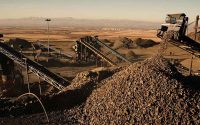Keyvan Jafari Tehrani, member of the Board of Directors and Chairman of International Affairs in Iron Ore Producers & Exporters Association of Iran (IROPEX), has numerous records in business and international affairs for the past three decades. This article reflects his opinion on Iran’s position in the field of mining as well as the country’s domestic and international status.
Hence, the exploration, extraction, production, processing, and export of minerals are not addressed adequately as the sector deserves. The best place that can be achieved by Iran in the production and processes of minerals is the tenth at the world level. However, it is not even among the first twenty countries concerning production.
Role of international agreement
The Joint Comprehensive Plan of Action (JCPOA) was certainly effective. We need to wait and see the plans and steps taken by the 12th government (Rouhani’s second term) to strengthen the mining sector. On the other hand, Tramp’s presence as the President of the United States has led to some attempt to undermine the JCPOA.
Undoubtedly, any measure to honor this international agreement will result in the expansion of foreign companies’ presence in the country. Based on a 2025 outlook, Iran is to attract $55bn for the development of steel, aluminum, and other minerals.
The sum of investments is high and merely possible through overseas investment. Any positive development in the implementation of the agreement could be in favor of Iran’s economy and mining sector.
Benefits of co-production
The mineral deposits in Iran are diverse and untapped. If a country is advanced in the mineral industry, it does not necessarily mean that it is rich with significant reserves.
However, I definitely say that there are vast amounts of untapped mineral deposits in Iran, and such wealth can make a significant contribution to the country’s economic development. Iran has a particular and strategic position in the MENA.
Upon upgrading its export facilities, Irancan use advanced import-export terminals in the area, including the Sohar Port in Oman. The region is equipped with advanced terminals for loading and unloading that can be utilized by Iranian companies, as well. In recent years, Oman has turned into a hub for mineral processing and production of upstream products such as pellets and steel bars. Meanwhile, the country enjoyed the cooperation of large companies such as VALE (Brazil) and Jindal (India).
400.000ton commodity can quickly be loaded in the port developed by the cooperation of Rotterdam Port (Netherlands).Likewise, steel plants are established by a joint venture between Oman and India.There is also an aluminum smelter plant.
Sohar Port can be a center for co-production and export of produced goods to a third country. Therefore, there is also a great chance of joint production in Iran, especially in upstream industries which results in a high added value.
It is essential for companies to pursue the creation of high value added. Given abundant and reasonable energy resources in Iran, the country is able to produce products at a low cost.
Development and area requirements
Considering the development of the mining sector for Iran is a fact that has been relevant to Saudi Arabia as well. Saudi Arabia plans to replace the mines with oil revenues by 2030.
In this regard, we have witnessed that Khalid A. Al-Falih, retaining his position as the Saudi
Oil Minister, is assigned as the CEO of the mines’ company to pursue the objectives of the country’s economic outlook 2030.Over eight years, the company has grown up to 392 percent which is an unprecedented figure. The new CEO leads a company with a value of
$31bn. These are all the advantages that Saudi Arabia has achieved in pursuit of its goals.The country has less problem in attracting foreign capital compared to Iran due to long-term planning.
We have also passed the same path. In Iran, the direct share of mining of GDP is about one percent. It reaches 5-6 percent by considering other trades and services associated with the mining sector, including transportation, railways, ports, and others. If this figure is compared with the role of oil, which accounts for at least 23 percent of Iran’s economy, we can figure out the gap between oil and mining sectors in Iran. In other words, the share of the mining industry of GDP needs to be increased about 23 times which is not achievable in the short term. Iran can play a decisive role in the mineral economy of the MENA Region if the country manages to solve the problem of attracting foreign investment.
Price index of Iran’s iron ore
Metal Bulletin has declared Iran’s 60 percentiron ore as an indicator over the past two years. However, the price basis of the iron ore is largely based on the Platts Indicator. The point is that a significant percentage of miners and people in business do not use the iron ore price index determined by Metal Bulletin. Iran mostly cooperates with Chinese parties in the iron ore business, and they do not trade by the Metal Bulletin’s price. Although the Metal
Bulletin Index can show price gap between Iran’s iron ore and that of other countries, it has still little practical application in current deals.
Effect of price realization
Iron ore price realization in Iran is a determining factor as the rate of trade in mineral products all over the world can be represented by a linear formula within the country. Of course, sometimes we witness a reversal trend in Iran as well. In the spring of 2017, the domestic sale price of iron ore was higher. If the price is determined globally, foreign investment will rise. I believe that before foreign investment, it is necessary to pay attention to the Iranian investors and the private sector. Also, if we awaken interest in Iranians living abroad, we will play a significant role in the development of the mining and its associated sector.






